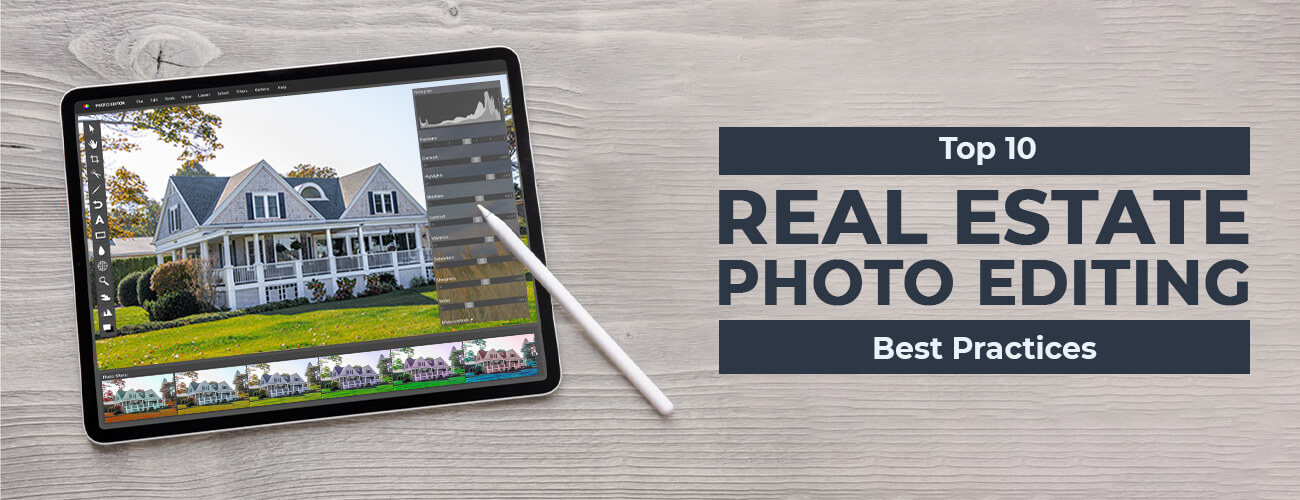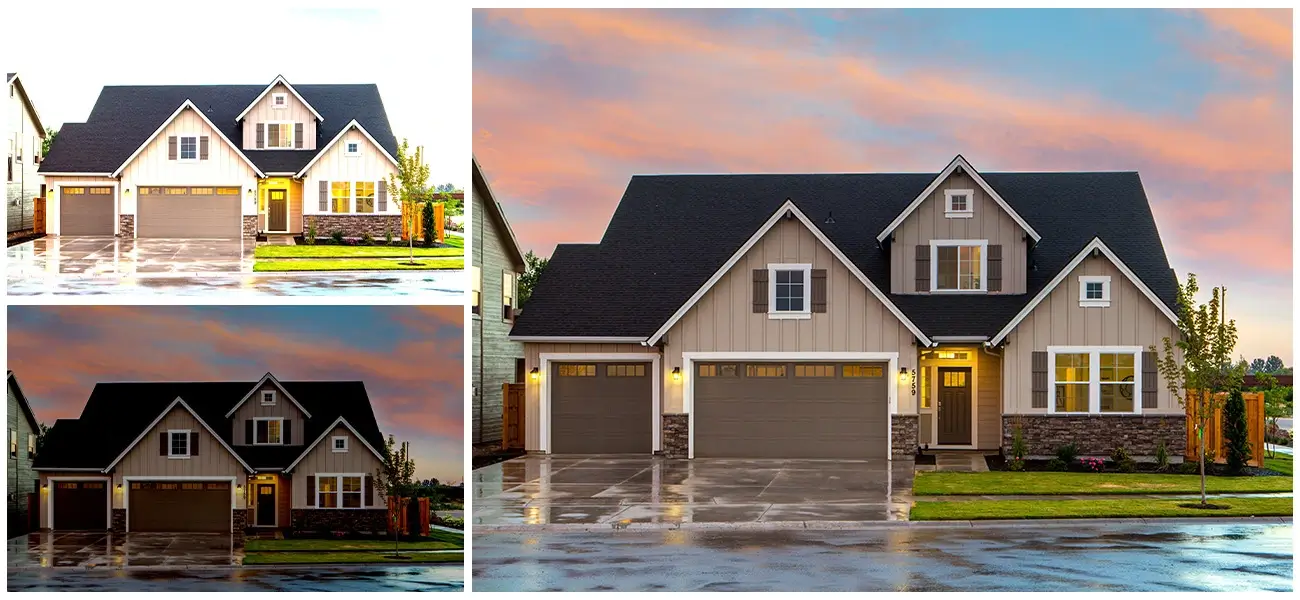Are you looking for expert tips and best practices to make your real estate photo editing stand out? Or are you a realtor who requires high-end images to attract prospects? If you fall into either of the two categories, this blog is for you. Keep reading until the end, and you will get a complete guide to the top 10 real estate photo editing practices.

Why is Photo Editing Necessary for Real Estate?
For any industry, professionally edited images are crucial. Especially in the real estate sector, where images are the first thing potential buyers see, Based on their first impression of the property, they make their choice. According to some studies, a listing with professionally edited photographs covering the property interiors and exteriors gains more views than those listed with very basic or no editing at a similar price. Dull and low-quality images fail to attract buyers and tarnish the brand’s image.
This is why it is vital to convert the pictures of your asset into what a potential buyer is looking for with high-end photo editing.
10 Best Real Estate Photo Editing Practices
To accomplish this task, one must be aware of some effective real estate photo editing techniques that enhance the images, bring out the best features of the property, and influence the psychology of your prospects. Be it showing lavish interiors or emphasizing the serene exteriors of your property, real estate photo editors know how to show the best angles of the areas of your asset, making them perfect for attracting tenants or buyers.
Here are some of the best practices to give you a head start.
-
Color cast removal

For any real estate image to perform effectively, color accuracy is paramount because it is one of the primary deciding factors for buyers. If the colors look unnatural, or too saturated, or too dull – it can be a deal-breaker.
Adobe Photoshop, Lightroom, and most other photo editors provide efficient color correction feature that you can leverage and adjust the level of saturation and hue. Give a realistic color appearance to the images utilizing these tools and see how they entice the prospects.
-
Light balance adjustment

Ideal lighting is highly vital to real estate images, as bad lighting adversely affects the essential highlights of the property. This is a major deal-breaker for any realtor that can be resolved with some light balance adjustment.
Properly balancing the light helps to create brightly lit images and fixes overexposure or dark areas in the image. Usually, overexposure or underexposure happens while shooting with artificial lights and reflective mirrors. Adobe Lightroom has robust light-balancing features that can adjust the highlights and shadows to create balanced images.
-
Image cloning

Another real estate photo editing best practice that can help you create mesmerizing property photos. Your property viewers wouldn’t like to see unwanted objects on the property photo.
The image cloning tool in Photoshop enables photo editors to eliminate distractions, fill in blank spaces, and enhance the beauty of the image. This process is also deemed as digital de-cluttering or object removal.
-
HDR blending

HDR photography is a technique for capturing a wider natural range of colors. Proper blending is required to blend various images with different brightness, contrast, and exposure to get an image that gives the exact look your buyer wants to see. A good HDR blending job will add balance to the appearance of the interior and exterior of the property.
Ideally, modern DSLR cameras have a built-in HDR image blending feature, but sometimes they don’t work perfectly. This shortcoming can be fixed using photo editing tools; alternatively, by partnering with an experienced photo editing team that provides HDR image blending services.
-
Noise reduction

Noise or grains in an image refers to the hazy dots present that affect the image’s clarity. These happen due to multiple reasons, viz, exposure time error, issues in pixel density, low lighting, sensor size, etc. Removing noise is a best practice when you start a real estate photo editing procedure. Reducing the image noise can make the images clearer, more appealing, and more vibrant.
Many online tools offer noise reduction/removal features; leverage them and get the best out of the image. Several professional photo editing agencies offer such services at a minimal cost; you may consult them also.
-
Sky replacement

Change the dull, rainy, or gray skylines with a clearer, brighter, and sunnier backdrop with sky-replacement techniques. Sky replacement is probably one of the most widely known best practices in real estate photo retouching.
Buyers don’t want to see an image that is overcast or gloomy; beautify the skyline with Adobe Photoshop’s or Lightroom’s advanced sky replacement feature and impress the clients with a bright, sunny photo of the property.
-
Photo manipulation

Photo manipulation for real estate is another best practice to accentuate property images by adding richness, visual effects, and saturation. By utilizing specific image manipulation techniques like burning, dodging, dispersion effect, double exposure, darkroom exposure, and paint splash, etc., you can take the photos one level up and amplify their appeal.
However, be careful not to overdo this technique, as it can produce an unrealistic image. There are a lot of highly efficient and expert agencies that can help you with effective photo manipulation services. Find the right real estate photo editing company for you and get started.
-
Perspective correction

Perspective correction can be a great menace, especially in real estate photography. Sometimes images have misalignment and angular distortions due to several factors, like the curvature of the lens, the room’s shape and size, the camera position, etc.
With some professional editing techniques, though, this issue can be fixed. Adobe Photoshop, Lightroom, Snapseed, PaintShop Pro, and several other photo editors come with robust perspective correction features. With careful use of the tools, you can correct the image by aligning the distorted horizontal and vertical lines with the image’s frame.
-
360-degree panorama photo stitching

This tip can boost your real estate photography portfolio one level higher. A 360-degree image of a scenario is a must for the real estate sector because it gives a complete view of the property in a single frame.
This is why new-age photo editing tools have introduced a 360-degree panorama photo stitching feature that can help you stitch regular-size photos to create a seamless 360-degree panoramic view of the space. It is one of the best practices for any beginner to consider. Just ensure that you stick the images sequentially without any indication of merging.
-
Day-to-dusk conversion

The standard “golden time” to capture any property photos is during dusk, when a warm glow surrounds the entire estate. Such images mesmerize potential buyers, compelling them to buy the plot. However, the challenge arises when the natural lighting is dull and murky. There’s a fantastic technique to fix this glitch: the day-to-dusk conversion.Utilizing the day-to-dusk conversion feature in Photoshop or any other leading photo editing tool, you can flawlessly adjust the contrast, sharpness, hue, and saturation of the photo, add brightly colored horizons, and many other elements. All these will make the photos appear to have been taken at dusk. This tip is like a modern-day magic for many photographers and photo editors.
However, this is also a very technical process that needs professional hands. So if you are on a tight deadline, you can always fall back on an expert agency offering real estate photo editing service.
Conclusion
If you have reached this point, then by now you have a fair understanding of the best practices for real estate photo editing. The above-mentioned techniques are tried and tested and can work wonders when executed perfectly. Professionally shot photos might not turn out to be great or as desired, but when photo editors have these editing best practices in their grasp, they can transform any dull property photos into amazingly dreamy pictures.
If you want to know more about how we help professional photographers and real estate owners with exceptional photo editing services, feel free to contact us!



